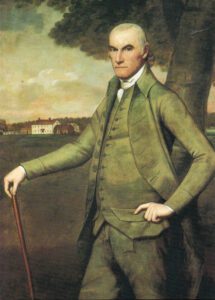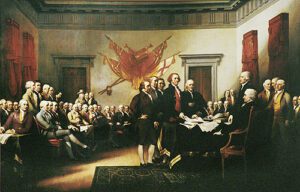
William Floyd was a New York state politician and a wealthy Suffolk County farmer. He represented New York in the Continental Congress and was a signer of the Declaration of Independence. The signers mutually pledged their lives, fortunes and sacred honor and Floyd paid the price when the British destroyed his property. He served in the New York Senate and in 1789 he was elected to the first Congress under the United States Constitution serving until 1791.
William was the eldest child of a prosperous Long Island family of Welsh descent. He was born on 17 December 1734 in Brookhaven Township, which is now known as Mastic, Long Island. His parents were Nicholl Floyd and Tabitha Smith.
The Floyd family occupied a 4,400-acre farm that had been purchased by William’s grandfather from the Tangier Smith family about 1688. The house where William was born was built by his father in 1723.
Since the Floyd family was wealthy and well connected, William would be expected to receive the best education available; however, fate intervened. When he was 17 years old his father died and being the eldest son, he inherited the estate and the responsibility that accompanied it. William did an outstanding job of rapidly learning how to manage such a large estate and how to profit from his products and his tenant farmers.

The property was highly productive with grains, forage, vegetables, orchards, and livestock. Since the property fronted on the Atlantic Ocean, William had a shipping dock for trade and for access to a variety of seafood. As estate owner, he dealt with a variety of trades people including carpenters, masons, farriers, and butchers. William’s education was a practical one. He thrived on his responsibilities and increased the family wealth and prestige.
As a successful, wealthy, and responsible landowner, William earned stature and influence in his community. The Floyd manor house welcomed an extensive circle of political and business connections as well as persons from other distinguished families. Many of the visitors had excellent formal educations and William absorbed much knowledge from them.
On 23 August 1760, William Floyd married Hannah Jones (or Johnes). Hannah was the daughter of William Jones of Southampton, Long Island. The couple had three children who all lived to adulthood. Little is known about Hannah, but we do know she was very patriotic and supportive of William’s political activities. She took over management of the estate because William’s political activities were requiring more time, and he was seldom home. She reportedly did an excellent job.
The 1763 Treaty of Paris ended the Seven Years’ War in Europe and the French and Indian War in the American colonies; however, it ushered in the American march to revolution. The wars had been quite expensive for Britain and the Crown looked to new taxes on the colonies to recover some of the costs. New taxes were also meant to require the colonies to pay more for protection by the British military. The American colonial population did not agree with the taxing logic and resisted.
As relations with Britain continued to deteriorate, men like William Floyd began to become even more prominent in politics. Floyd became active in Eastern Long Island, particularly in the town of Brookhaven where he was a trustee and an officer in the local militia. In 1769 he was elected to the Provincial Assembly where he became acquainted with political figures from other parts of New York Colony.

By 1775 relations with Britain had gotten worse and bloodshed occurred at the Battle of Lexington/Concord on 19 April. Soon after, Floyd was selected to be a New York delegate to the First Continental Congress. He became busy serving on several committees, and on 5 September he became colonel of the Western Regiment of Suffolk County Militia. Floyd split his time between congress and his military duties and kept the New York Provincial Congress informed on matters before the Continental Congress.
Floyd’s time in the Continental Congress was steady and supportive but he seldom spoke. South Carolina delegate Edmund Rutledge described Floyd as among the “good men who never quit their chairs.”

While General Washington, using the cannon Colonel Henry Knox had brought from Fort Ticonderoga, forced the British out of Boston, Congress was considering independence. New York had not instructed its delegation on the matter, so they were silent during the debate. They were unable to vote on Richard Henry Lee’s resolution for independence on 2 July or for the final draft on 4 July. They received instructions to vote for independence on 11 July, which resulted in a “unanimous declaration.” William Floyd and other delegates began signing the Declaration of Independence on 2 August 1776.
The British defeated Washington in the Battle of Long Island on 27 August 1776 and proceeded to overrun the entire island, including Floyd’s home during the next three months. Hannah Floyd barely had time to bury the family silver before the British soldiers arrived and destroyed the estate. Hannah, her three children, and a few neighbors fled across the island and sailed across Long Island Sound to Middletown, Connecticut to shelter with friends.
On 17 October 1776, William Floyd announced to Congress that “I am now going to try to get some of my effects from the island if it is possible, and shall be absent from Congress a few days, I beg you would excuse me as it is the first time I have absented myself.” Testament to the respect that Floyd had earned, Connecticut Governor Jonathon Trumbull sent an armed party across Long Island Sound to recover the remaining Floyd possessions.
Floyd never skimped on his responsibilities to his Militia unit or to Congress. He attained the military rank of Major General and served on several committees in Congress. He served a brief time in the New York Senate, but in January 1779 he was sent back to the Continental Congress.
Hannah Floyd died in Middletown on 16 May 1781 as a result of exposure, fatigue, stress, and unspecified illness. Apparently, the flight from their Long Island estate had long-term effects.
In 1783, after the war ended, Floyd returned to Long Island to find his estate consisted of ransacked buildings, desolate fields, uprooted trees, burned fences, lost livestock, and an unlivable house. He set to work to rebuild, but he also acquired land on the Mohawk River in Oneida County, which was in the frontier area of New York.
Widower William Floyd married Joanna Strong on 16 May1784. Joanna was the daughter of Benjah Strong and Martha Mills. William and Joanna had two children who both lived to maturity. Little is known about Joanna.
On 4 July 1787, Floyd was elected an honorary member of the New York Society of the Cincinnati. In March 1789, he was elected to the first United States Congress under the new Constitution serving until 3 March 1791. He was a presidential elector in 1792 voting for George Washington and George Clinton.

The Long Island estate was transferred to William’s son Nicoll in 1794. William and family moved to the large tract of land in Oneida County that he had purchased about ten years previously. In the area now known as Westernville, he built a new home that was essentially a copy of the one at Mastic.
In 1795, Floyd ran for Lieutenant Governor of New York with Robert Yates on the Democratic-Republican ticket, but they were defeated by Federalists John Jay and Stephen Van Rensselaer. Floyd was a presidential elector in 1800, voting for Thomas Jefferson and Aaron Burr and in 1804 when he voted for Jefferson and George Clinton. ilr
Floyd was again chosen as a presidential elector in 1820 but he did not attend the Electoral College meeting. Age apparently was catching up with him. Martin Van Buren served in his place.

Retirement to Oneida County was short for Floyd who died on 4 August 1821. He is buried in the Westernville Cemetery. Joanna Floyd died on 24 November 1826 and is buried next to William. The Floyd graves at Westernville are marked by a large rectangular monument with a plaque recognizing William as a signer that was attached by the Descendants of the Signers of the Declaration of Independence. William is also memorialized by a large horizontal stone at the Floyd Cemetery at Mastic.
William Floyd is remembered in New York by a statue at the Chamber of Commerce at Mastic and Shirley, by the William Floyd school district, the William Floyd Armed Forces Memorial, and the town of Floyd. The Mastic property of Willam Floyd is now a part of the Fire Island National Seashore and is open to the public. Eight generations of Floyds have managed this 25-room mansion and property. The Westernville home is still occupied and in private hands.
